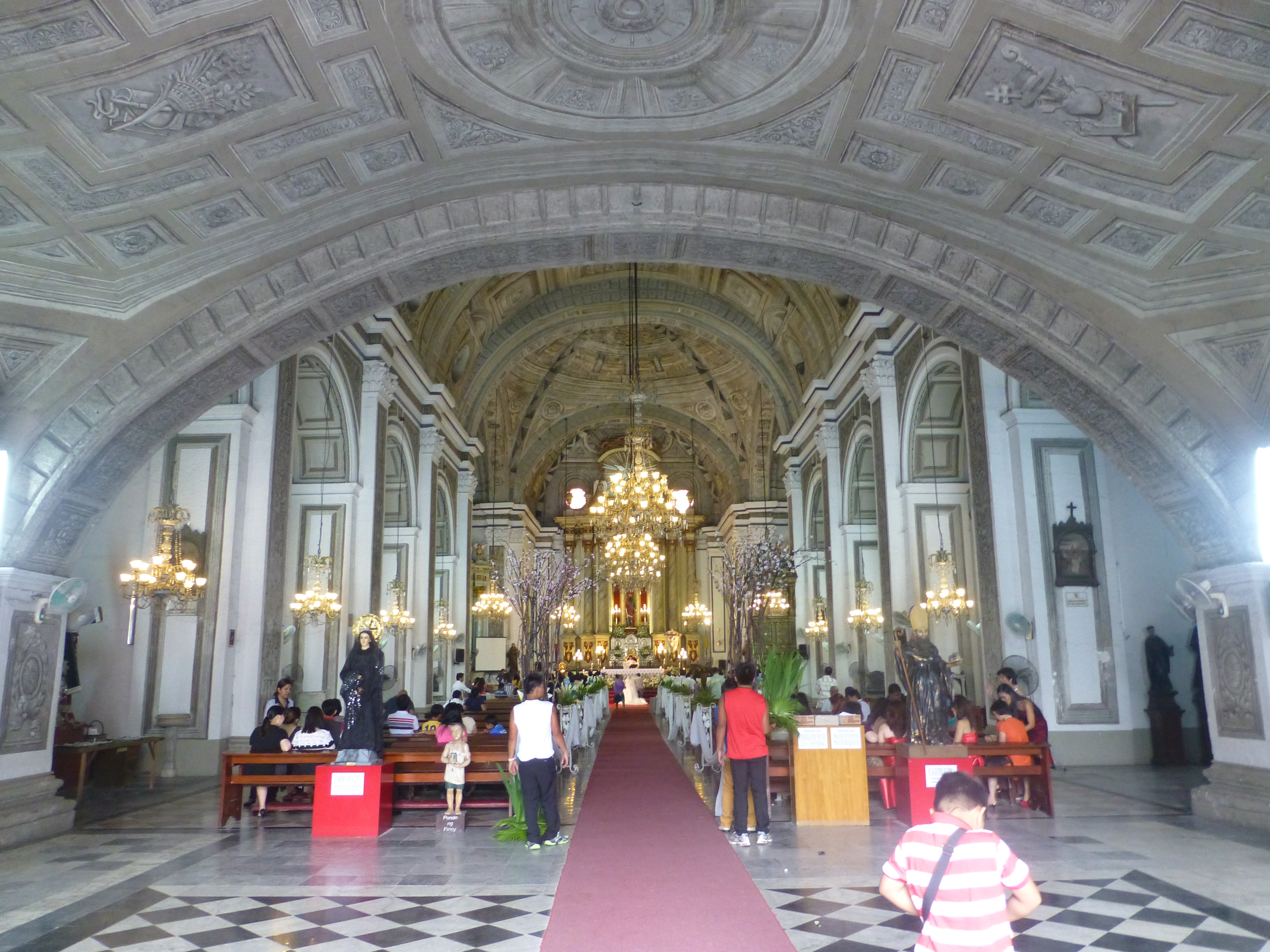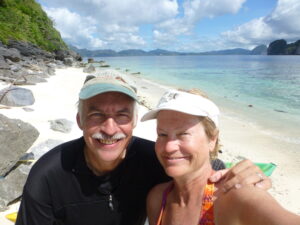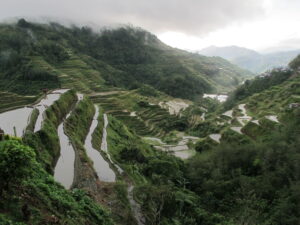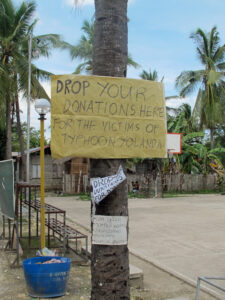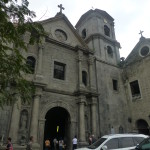
Impeccably dressed women flowered brightly against the grey backdrop. Formally suited men conversed quietly. Limousines and old cars moved slowly in and out of the small parking area, vigorously directed by a few parking managers.
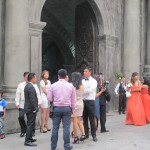
Behind them stood the grandest church in Manila, San Agustin, built around 1600 with a plain, but elegant exterior that reveals within a sumptuous baroque interior. It’s even been designated UNESCO World Heritage status. As it is also the oldest stone church in the Philippines, and the so-called wedding capital, every Saturday Filipinos wait their turn to enter through the grand double doors, fill the pews near the altar and celebrate the wedding of the next meringue-y bride. Every 45 minutes or so, the bride, groom and wedding party change over.
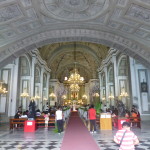
Unfortunately, because of all the weddings, we could only peek in as the ceremonies continued. Besides, the much larger Cathedral nearby, destroyed and rebuilt in 1958, seems dowdy in comparison, and we couldn’t visit it anyway because it’s under renovation.
This is not the image of Manila we had become accustomed to. We had arrived and departed the city six different times during our one month stay in the Philippines. Ferries can carry you from island to island but most flights over longer distances go via Manila so that’s where we connected as we moved around. During the stays in Manila, we spent quite a bit of time walking out and about.
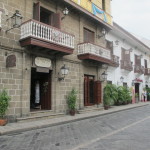
On our last day in the country, finally, we were visiting Intramuros (literally “within the walls,” walls that kept non-Spanish out), the central district of the city and the oldest.
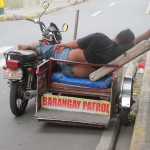
Intramuros dates from 1571, though much of it was smashed up in World War II. As the early Spanish colonialists preferred, this remains a quieter and more orderly section than most in this city, full of a few charming older buildings, pleasant streets, and neo-colonial offices. And it has a park where the defensive Fort Santiago stood, now newly restored after serving as a jail for colonial political prisoners and later dissidents. Though historically interesting, the inner city is not really glamorous, sadly full of corroding structures and empty lots amid the charming bits.
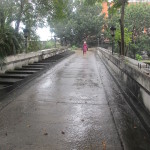
In this respect, Intramuros reflected the rest of the city, a place with huge contrasts between the world of the well-off and that of the poor. Just outside the walls, squatted the homeless, too poor or newly arrived to occupy even one of those ramshackle tin structures packed into several inner city neighborhoods. (See our post about Manila as a city of contrasts).
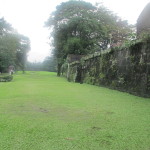
Oddly, just inside the old blackened walls at the western edge of the fortified city, a golf course wanders alongside. During one walk, we eased through a latched gate to access a surprisingly wide walkway atop the walls and, descending a ramp, found ourselves on the course with no way to get off it. The few Korean golfers didn’t seem too bothered however.
Especially on a Saturday, Intramuros felt like an oasis within this sprawling city of 17 million people. Beyond the walls, we had become accustomed to a frenzied Asian city – somewhat like Ho Chi Minh City (Saigon) without its colonial charm or Bangkok without its royal splendor. The place buzzes with energy and traffic, in a kind of orderly frenzy to a westerner.
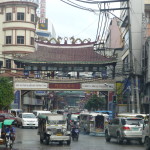
Traffic is often as bad as you will read about. Too many cars and buses and trucks; too few roads that bypass busy intersections. There are a few rail lines running overhead on concrete stanchions, but they don’t cover nearly enough of the crowded city.
It’s always rush hour here, without the rushing. Along eight-lane wide Roxas Boulevard, a main thoroughfare running by Manila Bay, all the vehicles inch along most of the day. A few kilometers east, on one driving venture, our car was stuck in the impasse around the central bus depots, with three or four layers of every form of conveyance pulled to the right toward the depot, or angling right-ish, while traffic tried to move around them in what space was left. Dozens and dozens of buses on their way to their depots filled out the melee.
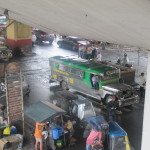
The chief form of local transport here – other than tuk-tuks – are the stretch jeepneys, as ubiquitous as taxis in Manhattan. Decked out in diverse chrome and painterly displays, they’re as much a city-wide art happening as a vehicle. They’re a heritage of World War II also, when an enterprising Filipino turned US Army jeeps into people movers. Each one plies a designated route, written along its side, for just a few pesos a ride. Full up, they can move a couple of dozen people along as they dart in and out of the rest of the traffic. Like taxis in Manhattan, they get you there, but they do make up a lot of the traffic jam as well.
Nimble as the jeepney drivers can be at times, even they face tough going. Getting to the airport, which by most measures is very close to the city center, was typically an adventure in road block, let alone if you tried to go longer distances. We came to cherish one driver who knew how to reach the airport by taking the long way adjacent to the Bay rather than the more direct– and time-consuming route – on Roxas.
After confronting all that hubbub in our visits to Manila, we savored the quietude and joy at the San Agustin church, the center of Intramuros, resistant to historical destruction and defying the frenzy beyond.
To us, the marriage celebrations and the church reflected the nature of the Filipino people we had met. The wedding parties gather here each Saturday in mutual joy and hope – despite the frenzied buzz of the streets outside, despite the mad politics of the country and despite the violent natural forces that threaten them, like the monster typhoon Hainan, which uprooted other families when we first arrived.
(Also, for more pictures from the Philippines, CLICK HERE to view the slideshow at the end of the Philippines itinerary page.)


